Cite - Notre-Dame de Paris

The builders of the cathedral
The building of Notre-Dame de Paris is part of the architectural explosion which lasted from the 11th to the end of the 14th century in western Europe, and especially in France.
In Paris , Bishop Maurice de Sully initiated the project. Though he was of humble stock, a peasant's son of Sully-sur-Loire, and thus had no personal income that enabled him to provide the funds for the building of the new cathedral, he remarkably managed his ecclesiastical income and therefore his financial contribution was of first importance. His successors: the first, Eudes de Sully, and other bishops such as Guillaume d'Auvergne or Simon Matifas de Buci, were eager in their own task to complete the building or to make some significant alterations.
The bishop was helped in his task by the chapter which, from the 9th century onwards, had grouped all the canons ministering in the cathedral. As documents are lacking, we don't know whether, during the 12th century, the chapter provided funds regularly to the work or not. Anyway, during the 13th century, as this chapter had its own benefices, it took a more and more important part in managing the work site, especially the building of the Hotel-Dieu (the Cathedral hospital).
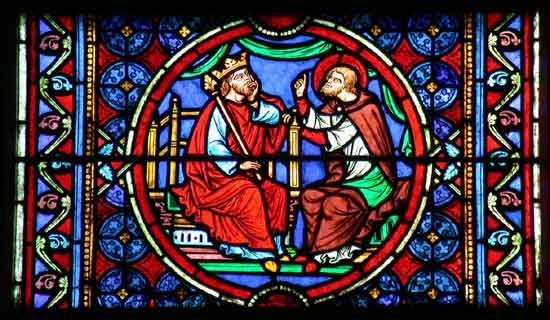
Contrary to some accepted ideas, the French king did not interfere in the building of the cathedral. In 1180 Louis VII made a donation before he died; the royal figures kneeling on the tympanum of the "Porte Rouge" are traditionally regarded as King Saint Louis and Queen Marguerite de Provence, which suggests that the king could have had a part in the rising of the cathedral.
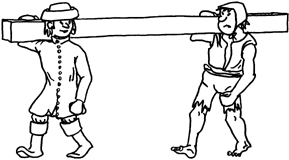
Still, we have no documents which could give evidence of this fact, therefore the cathedral can't be seen as a royal work site.
The people of Paris actually contributed financially through offerings, but they did not work freely on the site, as the story often goes.
For such a grandiose building, skilled workmen were required , thus, specialised and organised guilds were working on the site, and only unskilled workers were recruited locally and paid by the day.
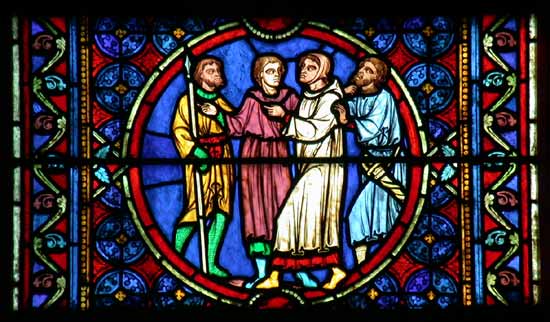
Among the craftsmen, the most important were the architects: they were real scientists and some 'master builders' were even called doctor lathomorum (doctors of stones).
Unfortunately the names of Notre-Dame de Paris first architects in the 12th and 13th centuries are not known. The first to be known is Jean de Chelles, who enlarged the north transept. He died in 1258 and his successor Pierre de Montreuil completed the south transept. Then Pierre de Chelles, altered the chevet into its present state, and Jean Ravy completed the choir screen.
The Crown of Thorns
Before he died on the Cross, Christ was mockingly crowned with thorns for he had claimed to be king of the Jews.
According to tradition, the Crown of Thorns was piously protected and venerated. It was mentioned in records of pilgrims to Jerusalem in the 4th century. The relic, the authenticity of which can't be asserted, was then sent to Constantinople and kept in the Byzantine Emperors treasury.
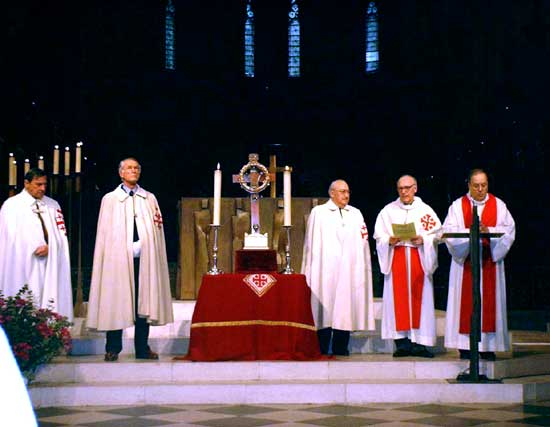
In the 13th century, it was pledged and then purchased by King Saint Louis who had the 'Sainte Chapelle' built in Paris to house it.
During the French Revolution, the Crown of Thorns was kept in the Bibliotheque Nationale (French national library).
In 1801 the Concordat with Rome gave it back to the Archbishop of Paris who in 1806 brought it to the Cathedral treasury where it remains.
The relic is as a ring of twisted rushes, to which thorns were attached to form the Crown.
Napoleon I and Napoleon III each gave a reliquary to protect it. The first reliquary is neo classical and the second is neo gothic, made by Viollet-le-Duc's workshop. Both are permanently exhibited in the Cathedral treasury.

The Crown itself is presented for veneration in the cathedral during Lent Fridays (and on Good Friday), as well as the first Friday of each month.

The presentation of the Holy Crown

Source of devotion and sometimes of miracles, they have been piously kept through centuries, in reliquaries that were all the more sumptuous as the relic was more remarkable. Reliquaries can be goldsmith's works and even buildings specially elevated to house the relics.
Obviously, Christ's relics, the instruments of the Passion, are the most precious in Christendom.
The Treasury
Three relics of Christ are nowadays kept in Notre-Dame de Paris treasury:
- the Crown of Thorns
- a piece of the Holy Cross
- one of the nails of the Passion.
The old treasury of Notre-Dame completely disappeared over the centuries and the pieces presently housed in the treasury were given in the 19th century.
The treasury is displayed in the neo gothic sacristy, built by Lassus and Viollet-le-Duc between 1845 and 1850 along the south flank of the monument.
The authenticity of those three relics can't be assured, but they have been presented for veneration since the late Roman Empire.
The Crown of Thorns was mockingly put on Jesus' head for he claimed to be king of the Jews.
The Holy Cross is the cross on which Jesus died. According to tradition, it was found by Saint Helena in Jerusalem in 326 and later was divided into numerous pieces that were spread all over Christendom.
The nail is one of those which nailed Jesus to the Cross.
Beside these three relics of Christ, Notre-Dame treasury also owns several relics of Saint Louis: some bones, his tunic and his scourge.
Lastly, a large amount of liturgical objects from different periods can be seen: religious gold plate, books and chasubles.

The stained glass windows
Relative darkness inside the cathedral fosters meditation and prayer. It also helps to discover the stained glass windows in better conditions.
In the Middle Ages, all Notre-Dame de Paris openings were fit out with magnificent stained glasses. All of them were destroyed in the 18th century except for the three marvellous great rose windows. In the 19th century, Viollet-le-Duc and his team created new medieval style stained glasses in for the choir and the side and ambulatory chapels. At last in 1960, Jacques le Chevalier created abstract stained glasses matching the colours of the three Middle Ages rose windows for the high windows of the nave and the openings of the galleries
The three large rose windows are first the West rose window (1220) half hidden by the great organ and then the two symmetrical rose windows of the transept. They have mostly kept their original stained glass, in spite of indispensable regular cleaning and restoration.
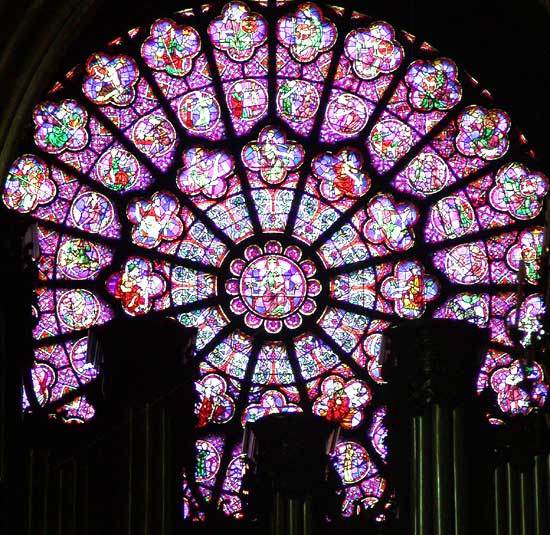
The West rose window (1220) is composed of three circles around a central medallion showing the Virgin and Child. In the inner circle the twelve minor prophets surround the Virgin and Child whose Incarnation they had announced. The pictures in each half of the outer two circles find their counterparts in one another. In the upper half the twelve virtues find their opposites in the adjacent circle in the twelve vices. In the lower half, the monthly activities of the year are set against the twelve signs of the zodiac. Number twelve, which is three (a symbol for Trinity) times four (a symbol for mankind) is symbolic of the Incarnation.
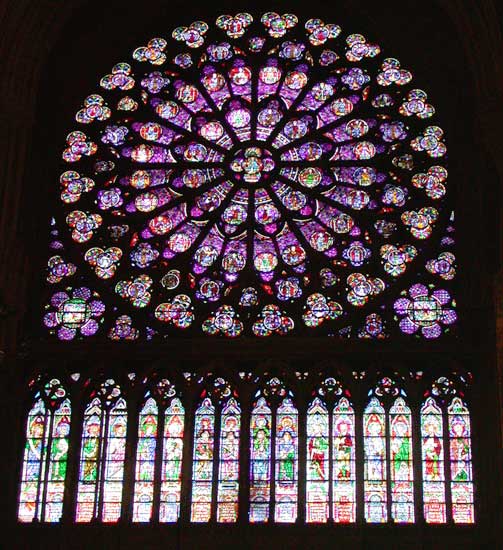
The North rose window (1250) is dedicated to the Old Testament. The predominantly violet shades of colour recall the long night of Israel waiting for the Messiah. In the centre, a picture of the Virgin carrying her child can be seen, the achivement of the promise, according to Scriptures. She is surrounded by eighty medallions distributed in three circles, showing eighty figures. The first circle is dedicated to the sixteen prophets, in the outer two circles kings, judges and high priests are represented.

The South rose window (1270) is dedicated to the New Testament. Its dominant shade of colour is red and it is much brighter because of its orientation. It is composed of eighty-four medallions distributed in four circles and featuring apostles, martyrs, bishops and scenes from the Gospel. The central medallion, created by Viollet-le-Duc's workshop, is an image of Jesus Christ as he is described in the Book of Revelation; he is surrounded by the Tetramorph.
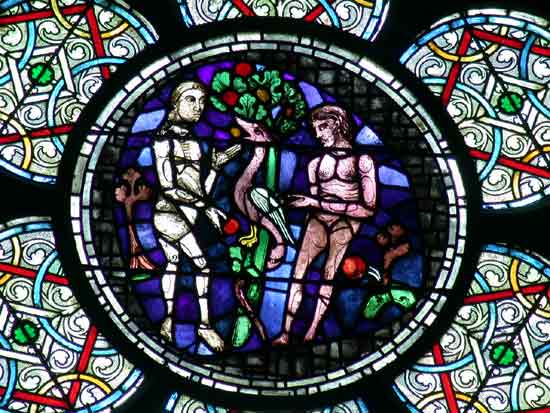
The stained glass of the clerestory under both rose windows were made in the 19th century by Viollet-le-Duc's workshop. On the North side, they feature the eighteen kings of Judah and on the South the sixteen prophets, the four major ones in the middle carrying the four Evangelists on their shoulders.
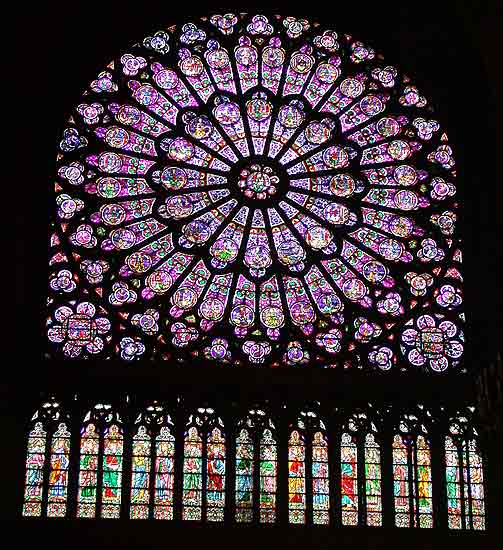

The "Bourdon", or Great Bell
The 'Bourdon', or Great Bell was installed in 1400 in the south tower. In 1683, King Louis XIV ordered it to be recast and renamed Emmanuel.
The 'Bourdon' weighs 13,000 kg and its clapper 500kg.
It only rings on festival days: Christmas, Palm Sunday, Easter, the Ascension, Whitsunday, the Assumption, All Saints, and on some exceptional celebrations.
In 1856, in the North tower, four new bells replaced those of the Middle Ages, which were melted down into canons at the French Revolution.
They ring three times a day at 8 a.m. for the Angelus, at noon, at 7 p.m. and also for the evening mass on weekdays.
On Sundays and festival days, all the bells ring at 9.45 a.m. and 3.45 p.m. To-day, ringing is remote controlled.